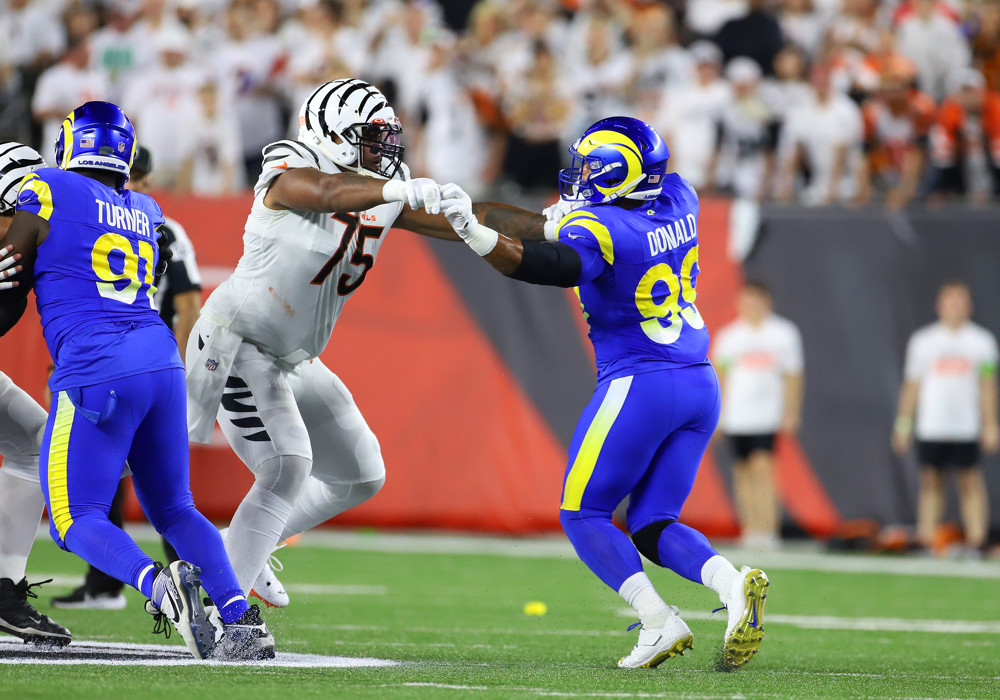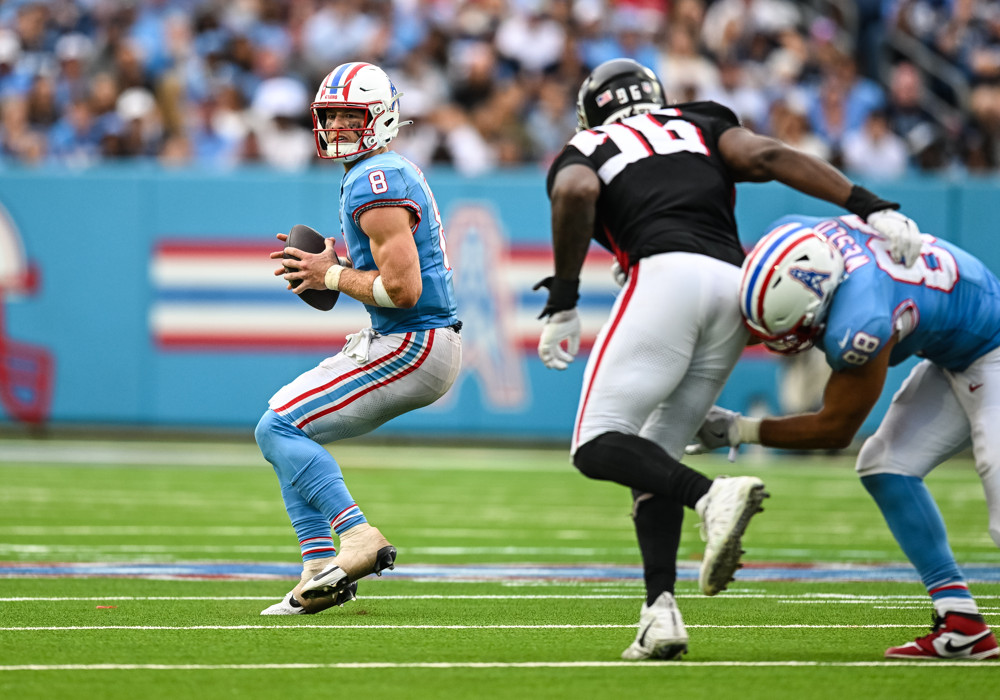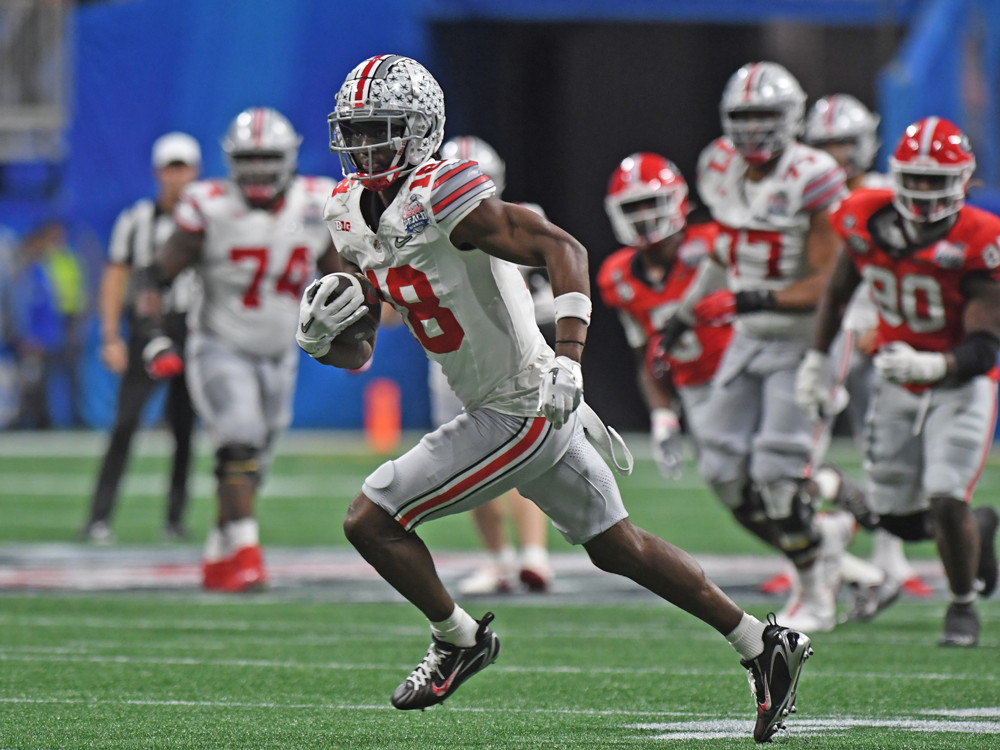
Touchdowns are on one hand everything in fantasy football, but they are also incredibly inconsistent.
Take this pair of Justin Herbert touchdowns from last season. On the first score, weak-side pressure forced Herbert out of the pocket. He barely had time to set his feet and unload the ball before a pair of pass-rushers crashed into him from opposite sides. And somehow Herbert still threw the ball 56 yards in the air to connect with the speedy Jalen Guyton, who had slipped past a corner and safety to the doorstep of the end zone, a depth those defenders no doubt believed Herbert couldn’t reach.
With his freakish arm talent and athleticism, Herbert may be the only quarterback in football who could make that throw. He may be the only quarterback ever who could make that throw. And yet, Herbert earned the same credit of one touchdown pass for that marvel as he did for this throw, a lob to the 6-foot-4 Mike Williams that only traveled 10 yards in the air because Williams cut to the left side of the end zone where no corner had a chance to defend him.
The seeming impossibility of the Guyton pass may be the only evidence one needs to label Herbert a standout passer. But that pass, and the Williams one, fall on the Giants’ and Chiefs’ respective defensive ledgers as equivalent passing touchdowns allowed and quickly lose context as statistics accumulate over the course of the season. So close to the end zone, that latter touchdown could have just as easily been an Austin Ekeler handoff, which would have reflected poorly on the Chiefs run defense even though Herbert threw for 37 of the Chargers’ 45 yards on the drive to advance 4 yards away from the end zone.
Football statistics have advanced past passing and rushing touchdowns allowed. Metrics like EPA and DVOA offer stable, predictive estimates of team offensive and defensive efficiencies. But those metrics were designed to evaluate the effectiveness of real teams and units. They are square pegs for the round hole of fantasy football, which continues to reward its players disproportionately for touchdowns, whether those touchdowns were exceptional, easy, or vultured from teammates who advanced their teams so close to the end zone.
In an effort to close the gap between real and fantasy football analysis, I created two new metrics, Expected Touchdown Passes Added and Expected Touchdown Runs Added — XTPA and XTRA — with advanced statistical principles in mind. Mike Clay’s opportunity-adjusted touchdown research showed that every play state has a league-average touchdown expectation, and that player sums of those expectations for their touches better predict their future touchdown scoring than their actual banked touchdowns do. Well, every drive state has a touchdown expectation, as well. As an example, this table shows how often drives lead to touchdowns after they reach a first down from between 1 and 10 yards from the end zone (DEZ).
| Drive Touchdown Rates for 1st Downs at Various Distances from the End Zone, 2015-21 |
||||
| DEZ | Plays | Pass TD% | Run TD% | TD% |
| 1 | 1081 | 27.1% | 60.6% | 87.7% |
| 2 | 546 | 34.2% | 50.7% | 85.0% |
| 3 | 549 | 40.8% | 43.7% | 84.5% |
| 4 | 600 | 35.0% | 41.2% | 76.2% |
| 5 | 602 | 41.4% | 34.1% | 75.4% |
| 6 | 553 | 39.2% | 29.1% | 68.4% |
| 7 | 606 | 41.1% | 23.8% | 64.9% |
| 8 | 622 | 39.7% | 27.0% | 66.7% |
| 9 | 647 | 42.5% | 18.5% | 61.1% |
| 10 | 585 | 38.5% | 22.9% | 61.4% |
As one would assume, the overall touchdown expectation increases almost uniformly as first downs get closer to the goal line. However, the ratio of passing to rushing touchdowns varies dramatically even for 1-yard differences. Rushing touchdown rates spike from a narrower band between 18% and 30% between 6 and 10 yards from the end zone to 50.7% and 60.6% on the 2- and 1-yard lines. Passing touchdown rates decline sharply from 3 to 2 and from 2 to 1 yards from the end zone as offensive coaches adjust their calculus from maximizing yards per play over the bulk of the field to minimizing turnover chances when their teams need to punch a drive into the end zone.
With a similar approach as an EPA calculation, XTPA and XTRA compare the expected passing and rushing touchdown rates at the start of and at the end of drives, add in credit for touchdowns created beyond the expected cumulative touchdown rates for the downs and distances from the end zone of every touchdown, aggregate those totals for defenses over the course of their games and then center on their league averages per game. That approach does several things that benefit fantasy players, in particular. First, it regresses for the small-sample choices of offenses to pass or run on the touchdowns they score near the end zone when either selection was likely to work for them. Defenses that allow a lot of drives to reach the goal line should allow a lot of rushing touchdowns whether or not Justin Herbert stole some of those previous scores on simple pass plays. Second, it captures pace. Even with equal defensive efficiencies, a team will allow more passing and rushing touchdowns than their counterpart if they allow offenses to run more plays per game. And third, it frames defensive efficiencies on a scale of extra passing and rushing touchdowns allowed, which complements the choices fantasy players need to make. Therefore, the differences in the metric results are easy to understand.
This table of XTPA and XTRA per game from the 2021 regular season illustrates that final point.
| Expected Touchdown Passes and Runs Added Per Gm, Defenses, 2021 | |||||
| Defense | Drives | XTPA | Rk | XTRA | Rk |
| BUF | 10.94 | -0.64 | 1 | -0.10 | 11 |
| NO | 11.47 | -0.44 | 2 | -0.16 | 4 |
| CAR | 11.59 | -0.29 | 3 | -0.15 | 7 |
| MIA | 11.35 | -0.26 | 4 | -0.02 | 19 |
| DAL | 12.00 | -0.23 | 5 | -0.23 | 2 |
| LAR | 10.65 | -0.23 | 6 | 0.04 | 22 |
| NE | 10.41 | -0.21 | 7 | -0.15 | 6 |
| PIT | 11.41 | -0.17 | 8 | -0.05 | 16 |
| TB | 11.24 | -0.13 | 9 | -0.12 | 10 |
| TEN | 10.94 | -0.11 | 10 | -0.10 | 13 |
| SF | 10.76 | -0.08 | 11 | -0.01 | 20 |
| CIN | 11.12 | -0.07 | 12 | -0.09 | 14 |
| SEA | 11.12 | -0.05 | 13 | 0.05 | 23 |
| PHI | 10.65 | -0.05 | 14 | 0.16 | 26 |
| NYG | 10.82 | 0.00 | 15 | -0.03 | 18 |
| JAX | 10.12 | 0.01 | 16 | 0.28 | 29 |
| DEN | 9.88 | 0.02 | 17 | -0.24 | 1 |
| CLV | 10.71 | 0.04 | 18 | -0.17 | 3 |
| ARZ | 10.41 | 0.05 | 19 | -0.13 | 9 |
| LV | 10.53 | 0.08 | 20 | 0.07 | 24 |
| HST | 11.12 | 0.09 | 21 | 0.38 | 31 |
| NYJ | 11.18 | 0.10 | 22 | 0.56 | 32 |
| LAC | 10.53 | 0.10 | 23 | 0.31 | 30 |
| MIN | 11.41 | 0.11 | 24 | -0.05 | 17 |
| BLT | 11.18 | 0.15 | 25 | -0.06 | 15 |
| IND | 10.65 | 0.22 | 26 | -0.16 | 5 |
| CHI | 10.47 | 0.22 | 27 | -0.14 | 8 |
| GB | 10.18 | 0.23 | 28 | 0.01 | 21 |
| KC | 9.94 | 0.26 | 29 | 0.13 | 25 |
| DET | 10.59 | 0.29 | 30 | 0.21 | 27 |
| ATL | 10.00 | 0.30 | 31 | 0.22 | 28 |
| WAS | 10.41 | 0.41 | 32 | -0.10 | 12 |
The Bills were the No. 1 pass defense by XTPA just like they were by pass defense DVOA (-23.0%) and the more traditional metric Net Yards Per Pass Play (4.8). But their -0.64 XTPA distills that the Bills allow 0.64 fewer passing touchdowns per game than a neutral team like the Giants (0.00) and more than a full passing touchdown per game less than the fantasy-friendliest opponent for passing scores, the Commanders (0.41). Meanwhile, XTPA and XTRA offer actionable fantasy advice that the established advanced defensive metrics can confuse because of their sometimes incompatible objectives. By their per play efficiencies, the 2021 Broncos had a worse run defense (-5.2% DVOA, where more negative numbers represent better defensive play) than the Jaguars (-5.9%). But because of some combination of the differences in their offenses, their pass defenses, their red-zone defenses and their pace, the Broncos and Jaguars were polar opposites, allowing 0.24 fewer and 0.28 more expected rushing touchdowns per game than an average team. As such, the Broncos were the No. 1 defense to avoid for rushing touchdowns, and the Jaguars were one of the five best to target!
XTPA and XTRA are not perfect predictors of future touchdown scoring. I tested the new metrics with split-half correlations since 2015, and XTPA from the first half of the season correlates with second-half passing touchdowns per game (0.186) better than first-half pass defense DVOA (0.163) but a little worse than first-half passing touchdowns per game (0.195). But XTPA has a signal. A near 50/50 weighting of first-half XTPA and passing touchdowns per game (0.199) correlates better than all three individual metrics. And critically for fantasy players, XTPA stabilizes much faster than passing touchdowns per game. XTPA has a 0.241 split-half correlation with itself versus the 0.195 correlation of passing touchdowns per game to itself.
| Defensive Pass TD Rate Predictor Correls, 2015-21 Weeks 1-9 vs. Weeks 10-17/18 |
||
| Metric | Itself | Pass TDs Per Gm |
| Pass Def DVOA | 0.163 | |
| XTPA | 0.241 | 0.186 |
| Pass TDs Per Gm | 0.195 | 0.195 |
| XTPA Regr | 0.199 | |
XTPA already achieves that stability with a 0.242 coefficient after the first four weeks of the season. In contrast, passing touchdowns per game have a lesser correlation of 0.185 to itself rest-of-season after the first month.
| Defensive Pass TD Rate Predictor Correls, 2015-21 Weeks 1-4 vs. Weeks 5-17/18 |
|
| Metric | Itself |
| XTPA | 0.242 |
| Pass TDs Per Gm | 0.185 |
That stability means that XTPA identifies predictive trends in passing touchdowns allowed in smaller samples, and that is how daily tournaments are won. XTPA becomes accurate earlier in the season and responds more quickly to changes in defensive effectiveness within the season after injuries and scheme changes. Because of that, it can help you beat the market on DFS salaries.
XTRA performs worse as a predictor of rushing touchdowns per game than XTPA does as a predictor of passing touchdowns per game with the same split-half correlation test. But like XTPA, XTRA smashes its rushing touchdowns per game counterpart with a 0.245 versus a 0.175 split-half correlation with itself. XTRA stabilizes more quickly.
| Defensive Run TD Rate Predictor Correls, 2015-21 Weeks 1-9 vs. Weeks 10-17/18 |
||
| Metric | Itself | Run TDs Per Gm |
| Run Def DVOA | 0.128 | |
| XTRA | 0.245 | 0.115 |
| Run TDs Per Gm | 0.175 | 0.175 |
XTRA doesn’t match its high standard of split-half self-correlation after the first four weeks the way that XTPA does. But XTRA continues to perform better in correlations to itself (0.118) than rushing touchdowns per game does (0.104) over similar spans of time. XTRA captures true tendencies more quickly over smaller samples and after real-world changes in defensive quality.
| Defensive Run TD Rate Predictor Correls, 2015-21 Weeks 1-4 vs. Weeks 5-17/18 |
|
| Metric | Itself |
| XTRA | 0.118 |
| Run TDs Per Gm | 0.104 |
As demonstrated by the Guyton touchdown, Justin Herbert is a gifted passer. The Chargers will likely lean on Herbert’s talent at the goal line and everywhere else. But for most teams, the choice to pass or run at the end zone is just a choice. For defenses that will mostly see a balance of pass-skewing and run-leaning opponents over even a small handful of weeks, XTPA and XTRA eliminate the noise of their opponents’ arbitrary pass or run play calls in the red zone. Since they stabilize quickly and predict the most important results for fantasy football — passing and rushing touchdowns — XTPA and XTRA are excellent metrics to inform your defensive matchup selections for passing and rushing DFS stacks.


































